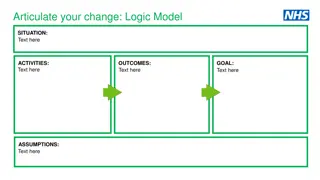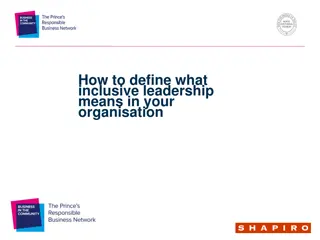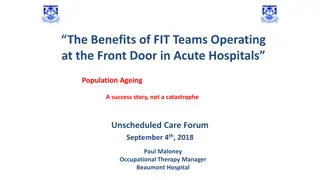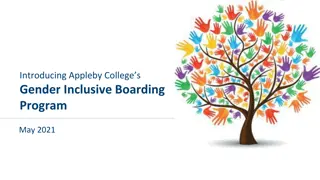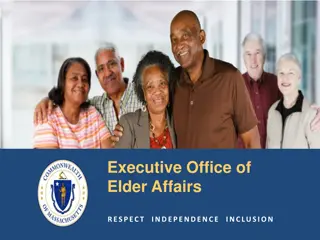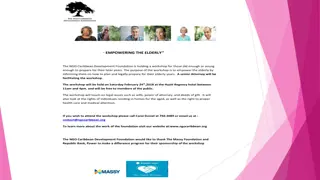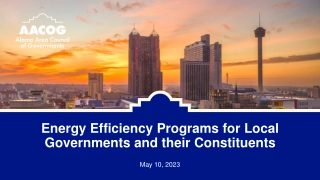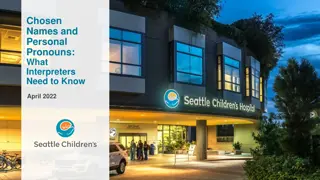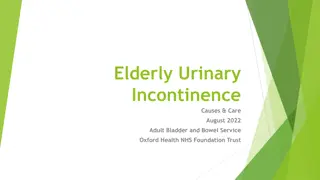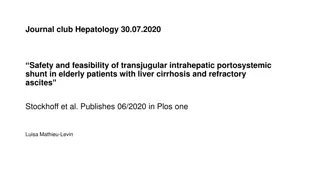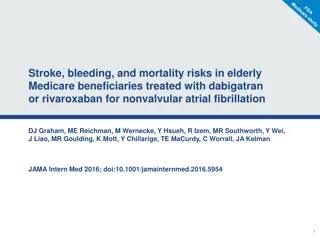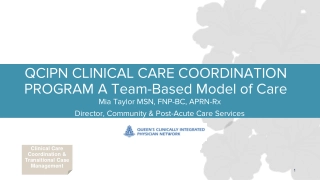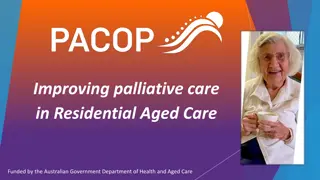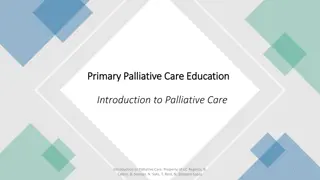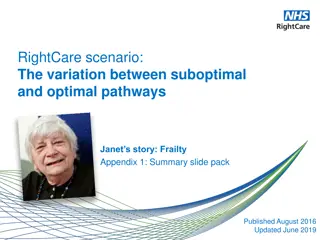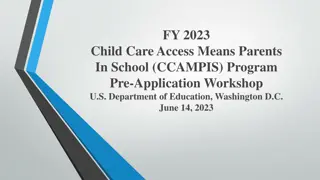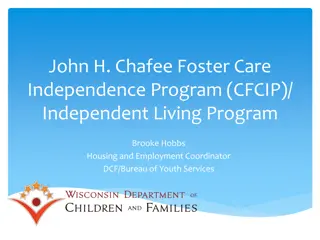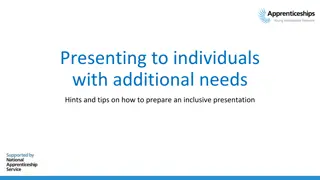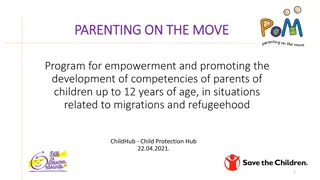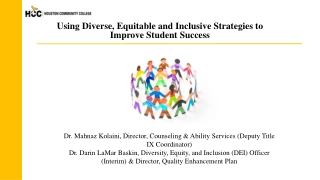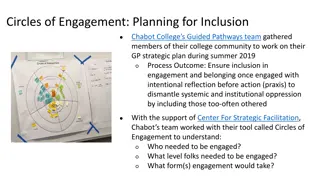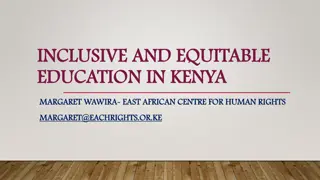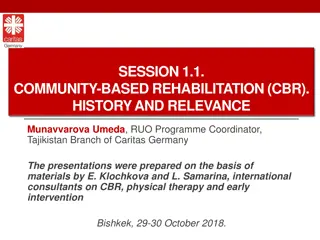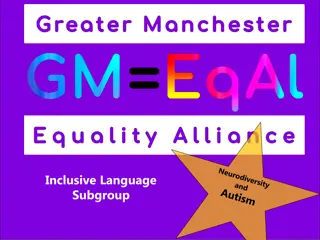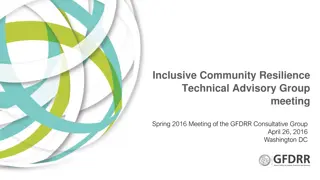Comprehensive Overview of the Program of All-Inclusive Care for the Elderly (PACE)
The Program of All-Inclusive Care for the Elderly (PACE) is a provider-based health program designed to serve frail individuals and their families in the community. Established in 1973, PACE offers a wide range of services including medical supervision, therapies, nutrition, transportation, and socialization. Participants receive personalized care plans from interdisciplinary teams, ensuring they can continue living in their communities while receiving necessary care and support.
Download Presentation

Please find below an Image/Link to download the presentation.
The content on the website is provided AS IS for your information and personal use only. It may not be sold, licensed, or shared on other websites without obtaining consent from the author. Download presentation by click this link. If you encounter any issues during the download, it is possible that the publisher has removed the file from their server.
E N D
Presentation Transcript
Kansas Department for Aging & Disability Services Program of All-Inclusive Care for the Elderly (PACE) Presented to: House Social Services Budget Committee January 26, 2021 Presented by: Janis DeBoer, Deputy Secretary
Program of All-Inclusive Care for the Elderly (PACE) History of the Program of All-Inclusive Care for the Elderly (PACE) The PACE model of care was created in 1973 in an effort to help the Asian-American community in San Francisco care for its elders in their own homes. This initial program created an innovative way to offer a comprehensive array of medical supervision, physical and occupational therapies, nutrition, transportation, respite care, socialization, and other needed services using home care and an adult day setting. In 1986, the Robert Wood Johnson Foundation provided funding for six additional sites to develop PACE demonstration programs made possible by Congressional authorization of additional Medicare and Medicaid waivers. Based on the success of the demonstration programs, PACE transitioned to a permanent provider type. The Balanced Budget Act of 1997 approved the granting of provider status to PACE programs under Medicare and gave states the option of including PACE as a Medicaid benefit. 2
Program of All-Inclusive Care for the Elderly (PACE) What is the Program of All-Inclusive Care for the Elderly (PACE)? The Program of All-Inclusive Care for the Elderly is a comprehensive, fully integrated, provider-based health program based on the belief that it is better for frail individuals and their families to be served in the community whenever possible. PACE programs coordinate and provide all needed preventive, primary, acute, and long-term care services so that their participants can continue to live in their communities as long as possible. 3
Program of All-Inclusive Care for the Elderly (PACE) PACE Model PACE participants are served by a comprehensive team of professionals. Participants and their caregivers meet with an Interdisciplinary Team (IDT) that includes doctors, nurses, therapists, social workers, dieticians, personal care aides, transportation drivers, and others. Participant needs are assessed, and an individualized care plan is developed to address all participant needs. 4
Program of All-Inclusive Care for the Elderly (PACE) PACE Model PACE Participants receive regular high-touch care and support. PACE participants receive their health and supportive services across a variety of settings. At the PACE center, they may receive primary care, therapy, meals, recreation, socialization, and personal care. In the home, PACE offers skilled care, personal care services and various supports. In the community, PACE provides access to specialists and other providers. 5
Program of All-Inclusive Care for the Elderly (PACE) Who does PACE serve? PACE serves individuals who are age 55 or over and certified by the state as needing a nursing home level of care. The average PACE participant has multiple complex medical conditions, cognitive and/or functional impairments, and significant health and long-term care needs. PACE participants must live in a PACE service area and be able to live safely in the community with PACE services at the time of enrollment. 6
Program of All-Inclusive Care for the Elderly (PACE) What benefits does PACE offer? PACE covers all Medicare Parts A, B, and D benefits, all Medicaid-covered benefits, and any other services or supports that are medically necessary to maintain or improve the health of PACE program participants. Primary Medical Care In-home Services Prescription Drugs Specialty Care Dentistry Audiology Optometry Podiatry Speech Therapy Respite Care Transportation Adult Day Services Nursing Meals Nutritional Counseling Social Work Personal Care Physical, Occupational, and Recreational Therapies Hospital and Nursing Home Care, when necessary 7
Program of All-Inclusive Care for the Elderly (PACE) How is PACE funded? PACE organizations receive a fixed monthly payment from Medicare, Medicaid, and private payers (for participants who are not dually eligible). These funds are pooled and care is provided based on the assessed needs of the participant. This capitated payment provides incentive to the PACE organizations to avoid duplicative or unnecessary services and encourages the use of appropriate community-based alternatives to hospital and nursing facility care. The state budget includes funding for the Program of All-Inclusive Care for the Elderly (PACE). FY 2021 funding for PACE totals $37.9 million, of which $13.8 million is from the State General Fund. For FY 2022, PACE totals $42.7 million, of which $17.1 million is from the State General Fund. 8
Program of All-Inclusive Care for the Elderly (PACE) PACE in Kansas Kansas first PACE organization was Via Christi HOPE PACE. The program began in 2002. Midland Care became a PACE organization in 2007. Bluestem Communities became a PACE organization in 2015. 9
Program of All-Inclusive Care for the Elderly (PACE) Program of All-Inclusive Care for the Elderly (PACE) Service Map Kansas PACE Organizations Via Christi HOPE Midland Care Bluestem Communities 10
Program of All-Inclusive Care for the Elderly (PACE) Via Christi Hope Midland Care Bluestem Communities Sedgwick Douglas Jackson Jefferson Leavenworth Lyon Marshall Nemaha Osage Shawnee Pottawatomie Wabaunsee Wyandotte McPherson Ottawa* Saline Rice* Marion Reno* Harvey *PACE is available in limited zip codes within these counties. 11
Program of All-Inclusive Care for the Elderly (PACE) PACE Enrollment PACE Program Enrollment Ascension Via Christi Hope 254 Midland Care 380 Bluestem Communities 91 Total PACE Enrollment 725 Note: Data as of January 20, 2021. 12
Program of All-Inclusive Care for the Elderly (PACE) Questions? 13


